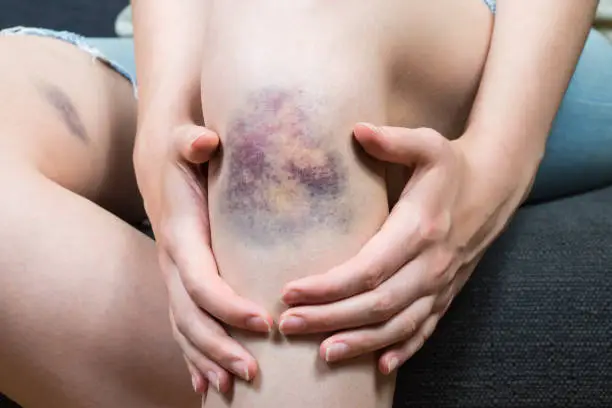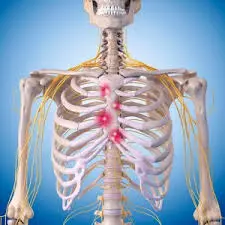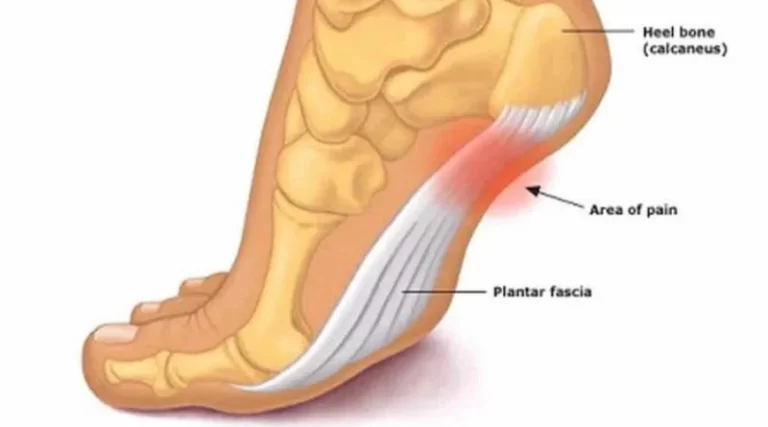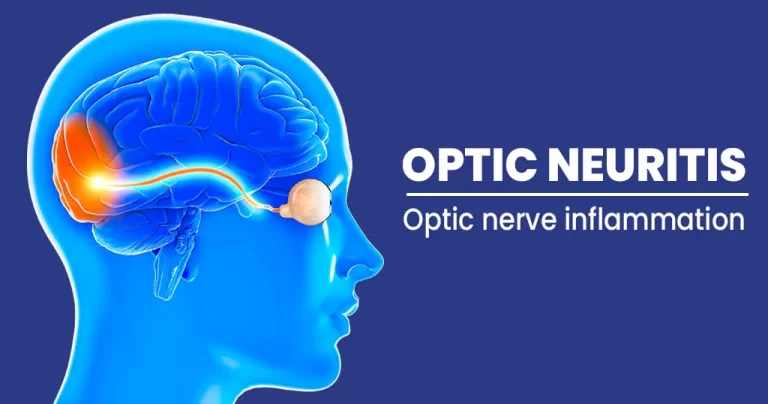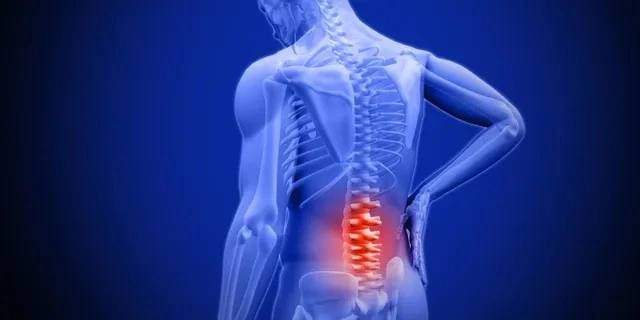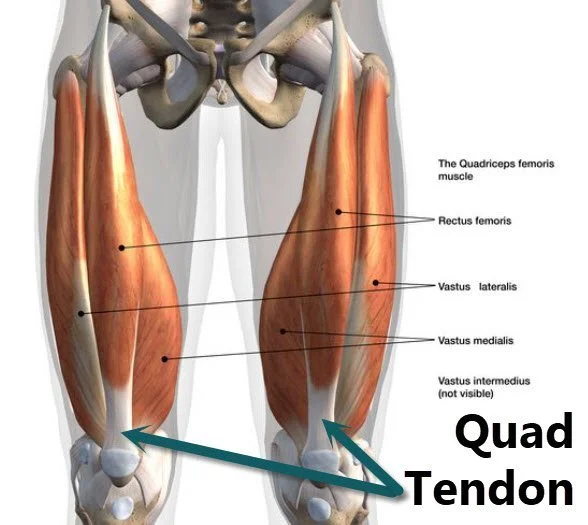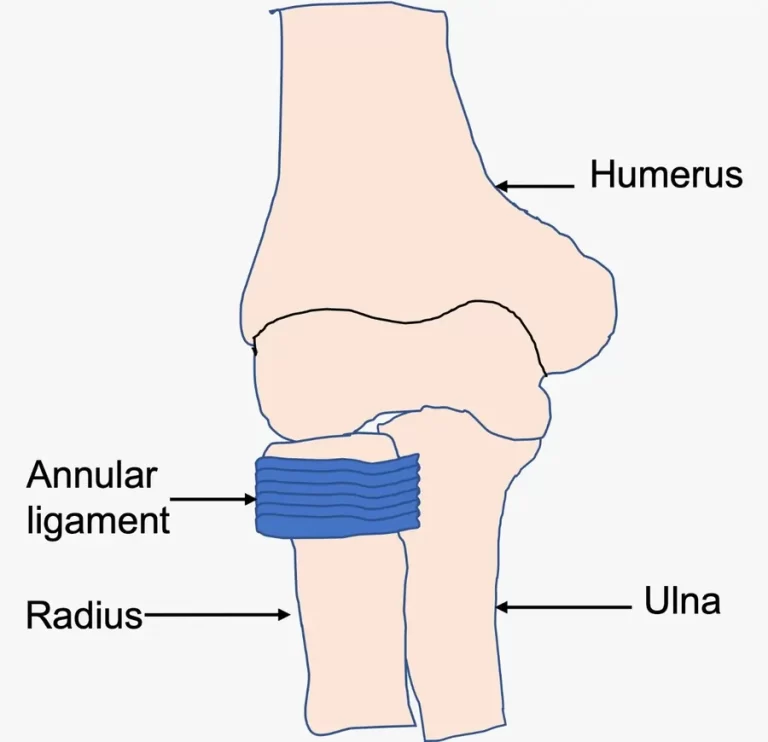Bruises (Ecchymosis)
A Bruises, also known as ecchymosis, is a common skin discoloration caused by bleeding beneath the skin due to trauma or injury. It typically appears as a purplish, blue, or black mark that changes color as it heals. Bruises may be tender to the touch and often resolve within one to two weeks without treatment. In some cases, underlying medical conditions or medications may increase the risk of bruising.
When injured, blood can pool from the vessels (veins and capillaries) beneath your skin. The bruise-like discoloration on your skin is due to blood that has collected on the surface. For individuals with lighter skin tones, bruises may initially appear red or purple shortly after the injury, transitioning to light brown, green, or yellow as they heal. For individuals with darker skin tones, bruises may appear purple, dark brown, or black.
What is a bruise (ecchymosis)?
The term “ecchymosis” is used in medicine to refer to a bruise. A bruise, also known as a contusion, occurs when blood vessels beneath the skin are damaged and leak, resulting in skin discoloration. Although blood is collecting under your skin, you will not experience any external bleeding unless your skin ruptures.
When blood collects, a bruise becomes visible. Bruises create a mark on your skin that can vary in color from black, blue, purple, brown, or yellow. The blood cells in your body fix injured blood vessels to assist in your healing process.
Types of Bruises
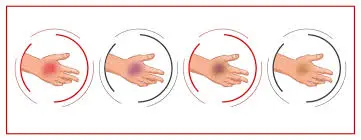
Three types of bruises are:
- Subcutaneous, indicating a bruise located just beneath the skin
- Intramuscular, indicating a bruise located within a muscle beneath your skin
- Periosteal, indicating a bruise on your bone
Ecchymosis vs. bruise
The term “ecchymosis” refers to a bruise in medical contexts. With a circumference of roughly 1 cm, an ecchymosis is comparable to that of a triple-A battery.
Hematoma vs. bruise
A hematoma is a large accumulation of blood that can result from a severe injury, like a significant fall or an automobile accident. Hematomas are typically painful and can cause the skin above them to feel raised, spongy, rubbery, and lumpy. Hematomas are more severe than ecchymoses and usually require medical attention.
Purpura vs. bruise
Purpura are tiny blood spots located beneath the skin. They range from roughly 4 millimeters in diameter (similar to that of an aspirin tablet) to 10 millimeters in diameter (similar to that of a triple-A battery). Thus, they are smaller than an ecchymosis but larger than petechiae. On lighter skin tones, they may appear reddish-purple, while on darker skin tones, they may look brownish-black.
Petechiae vs. bruises
Petechiae refer to tiny spots (pinpoint or measuring under 2 millimeters) of blood beneath the skin or within mucous membranes, like those in your mouth or on your eyelids. They resemble a rash with purple, red, or brown blood spots, but they are not bumpy. They are generally not painful and do not itch.
Common Bruise Locations
Bruised ribs
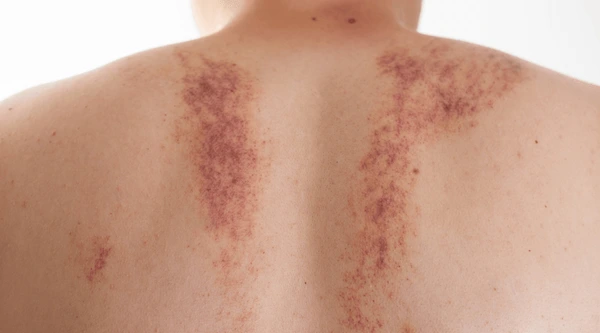
A fall, a chest injury, or intense coughing can lead to bruised or fractured ribs. You might be able to determine whether you have bruised ribs if you:
Experience severe chest pain, particularly upon inhalation. Notice swelling or sensitivity in your rib area. Observe a bruise on the skin covering your ribs. Typically, bruised ribs heal on their own within 3 to 6 weeks. As there is no simple method for splinting bruised or fractured ribs, doctors typically allow them to heal naturally. You can assist your healing through the following methods:
- Cough as necessary while breathing normally, as this aids in clearing mucus from your lungs and can help prevent chest infections such as pneumonia.
- When you cough, press a pillow to your chest to support your ribs.
- Regularly cycle and move your shoulders to help clear mucus from your lungs.
- Every hour, do 10 deep breaths at a slow pace.
- Avoid smoking.
- Don’t restrict your ribs, as this could stop the full expansion of your lungs.
- Avoid lying down or remaining motionless for extended periods.
- Avoid putting strain on yourself and lifting heavy things.
Bruises on legs and arms

The most common areas for bruises to occur are your arms and legs. They can result from falling, sustaining injuries while playing sports. Due to generally thinner skin and smaller blood vessels, individuals over the age of 65 and those assigned female at birth (AFAB) are more prone to bruising compared to other groups.
If you notice a bruise on your arm or leg along with signs of a blood clot in that same limb, contact your doctor. Symptoms of a blood clot consist of increasing redness and swelling, along with limb pain. For example, if you have a blood clot in your leg, you might experience pain in your calf, the area behind your knee, or in your thigh or groin.
Bruise under a nail
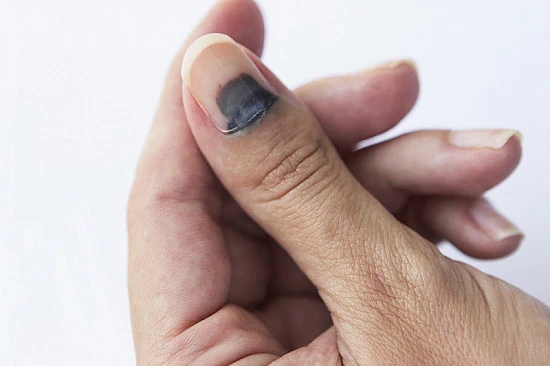
This is referred to by doctors as an injury of the nail bed hematoma. It can occur from hitting your thumb with a hammer or stubbing your toe, but it can also result from wearing tight shoes or marathon training. Your nail might feel sore or tender right after the injury, but the pressure that accumulates beneath your nail as blood collects can lead to intense pain. Your nail might detach from your finger or toe, and its color may change. If you have bleeding that won’t cease, excessive pain, or extensive damage at the base of your nail, you should visit your doctor.
If needed, your doctor can puncture your nail to release the blood and fluid that have accumulated underneath. Usually, this resolves the pain. Since doing this on your own could lead to additional injuries, infections, and a delayed recovery, it’s best not to attempt it.
A new nail typically takes around 6 to 9 months to grow in. However, if the cells responsible for your nail’s regrowth (known as the nail matrix) are harmed, the nail may grow inappropriately or may not regrow at all.
Bruised tailbone
Your tailbone is medically referred to as the coccyx, which is why your doctor may refer to an injury in this area as a coccyx injury. If you fall backward onto a hard surface, such as when you slip on a wet floor or a patch of ice, you may bruise your tailbone. Signs of a coccyx injury include:
Pain or sensitivity in your lumbar region, or Pain in the upper part of your buttocks. Pain or lack of sensation while seated, A contusion or inflammation on the skin at the lower end of your spinal column.
Injuries to the tailbone can cause significant pain. It can take as long as 4 weeks for them to heal. Using a cushion or gel when sitting can help speed up your recovery by relieving pressure on your tailbone. Moreover, try sleeping on your stomach rather than your back. Since using the toilet can hurt, be sure to consume enough fiber and fluids to prevent constipation.
Bruise on the breast.
After a fall or a car accident where the seatbelt restrains you, there is a possibility of developing a bruise on your chest. Although it is uncommon, some individuals can develop a hematoma following surgical procedures on the breast, including breast reduction surgery, breast cancer surgery, or biopsies. In this situation, you can assist your healing process by adhering to the standard recommendations for bruises: apply ice packs during the initial 1–2 days, switch to heat afterward, and use nonprescription pain relievers like acetaminophen.
Although it is quite uncommon, a bruise on your breast can occasionally indicate a breast infection (mastitis) or inflammatory breast cancer. In this case, you will probably notice additional symptoms like a swift breast-size increase, heaviness, burning sensations, or tenderness in the breast area, skin ridges or pitting, or a nipple that’s turned inward. Additionally, you might observe swollen lymph nodes in your close to your collarbone on the same side as the bruised breast.
If you notice a bruise on your breast and are unsure of its cause, or if you experience other symptoms, consult your doctor.
Bruise on the bottom of the foot.
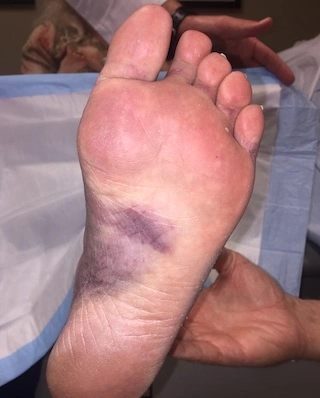
- Individuals who run regularly might develop a condition known as metatarsalgia or a stone bruise. This refers to the swelling and tenderness at the connection point of your toe bones on the underside of your foot. You may have skin discoloration. A stone bruise may cause pain or tenderness when you apply pressure to the affected area of your foot, pull your toes up, or flex your foot upward. It can result from training in old or worn shoes, running or walking on hard surfaces such as concrete, or excessive training duration.
If you have a stone bruise, it’s important to refrain from running, avoid walking without shoes, and adhere to the standard bruise treatment recommendations: Utilize ice packs for the first one to two days, then switch to heat and take non-prescription pain relievers. If it occurs frequently, you might consider trying a different kind of running shoe or using a cushioning insole while running. Consulting a sports physician might be beneficial, as they can assist you in determining how to prevent them.
Bone bruise
Sometimes, a bone bruise is referred to as a microfracture. Although it’s not as serious as a fracture, the injury has harmed some portion of your bone’s internal structure. All types of bones in your body can survive bruises; if this happens, it is possible that surrounding structures in your skeleton, such as ligaments (the tissues that connect your joints and bones), will also suffer damage. Bone bruises can occur due to sports injuries, car accidents, falls from heights, joint sprains, or medical conditions such as arthritis.
Bone bruises tend to last longer (1-2 months) and are more painful than soft tissue bruises, but most can heal with rest and the same home care as for other types of bruises. For bone bruises in your legs and feet, your doctor will likely recommend using a brace or crutches. In rare cases, if your bone bruise is exceptionally large, you might not regain blood flow in that area. This could result in the death of part of your bone. If your symptoms don’t improve within a few days or if you experience any signs of an infection, like a high fever, contact your doctor.
Who gets bruises?
Everybody will experience bruises at some point in their life. Bruises may result from falls, accidents, sports injuries, or medical procedures.
Some medical conditions and bleeding disorders can increase your susceptibility to bruising, such as:
- Suffering from cancer or liver disease.
- Having relatives who are prone to bruising.
- Using medicines that prevent blood clotting or make the blood less viscous, like aspirin or anticoagulants.
- Using nonsteroidal anti-inflammatory drugs (NSAIDs) such as ibuprofen (Advil®) or naproxen regularly to reduce pain.
- Possessing a bleeding disorder like hemophilia, Von Willebrand disease, or another blood clotting condition.
- Having a low blood platelet count (thrombocytopenia).
- Deficiency in vitamin C or vitamin K.
Stages of bruising
As your body recovers, bruises take on different colors based on your skin tone. The color changes indicate that your body is decomposing the blood cells accumulated in your skin. It’s a component of your body’s self-repair process.
The usual phases of a bruise are determined by the color shifts that occur in individuals with lighter skin tones.
These phases consist of:
- When the injury occurs or shortly thereafter, you will develop a bump that appears red or purple. You may experience swelling and tenderness of the skin.
- In a few days, your bruise might appear blue or black.
- In 5-10 days, your bruise might become green or yellow.
- In 10 to 14 days, your bruise may appear light brown, and it will progressively lighten until it blends with your natural skin tone.
With darker skin tones, redness may not be apparent at the time of injury. Rather, you might notice a bump beneath your skin that could be sensitive to the touch. As the bruise matures, the skin covering your bruise might appear dark brown or black. Individuals with medium skin tones might notice a greater presence of red and yellow color in their bruises compared to those with lighter or darker skin tones.
Yellow bruise
A study demonstrated that the emergence of a yellow color was the most prominent change in a bruise as time passed. In individuals under 65, the emergence of a yellow condition occurred at a much quicker pace. The research also demonstrated that yellow bruises were typically over 18 hours old.
How bruises change color
The colors of bruises vary based on factors like the severity of the injury, the body part affected, and an individual’s skin tone.
From its color, an individual might be able to measure the age of a bruise. As the body recovers and metabolizes hemoglobin, the substance responsible for blood’s red color, the bruise will undergo color changes. This is a normal aspect of the healing process.
The color of the skin affects how bruises look. According to a study conducted in 2013, individuals with medium skin tones may exhibit bruises containing more red and yellow color compared to those with lighter or darker skin tones. On darker skin tones, bruises tend to look darker and exhibit fewer visible color changes compared to those on lighter or medium skin tones.
As it heals, a bruise typically changes colors in the following ways:
- Within 24 hours of an injury. A bruise usually begins as red because fresh, oxygenated blood accumulates beneath the skin. For individuals with darker skin, reddening may not be evident; however, their skin may appear to become darker.
- After 1–2 days. The blood starts to lose oxygen and change its color. Skin that has been bruised for several days will frequently take on a blue, purple, or black color, or will appear somewhat darker than skin that has not been bruised.
- After 5 to 10 days. The bruise may develop a yellow or green color on lighter and medium skin tones. The body generates these colors from substances known as biliverdin and bilirubin during the breakdown of hemoglobin. With darker skin, the color of bruises may become lighter.
- After 10–14 days: For lighter skin tones, a bruise may develop a yellowish-brown or light brown color. With darker skin tones, a bruise will fade over time.
The majority of bruises will fade away on their own within approximately 2 weeks, without any treatment. Find out more about bruising on darker skin tones.
Causes of bruises (ecchymosis)
Bruises appear on your skin due to ruptured blood vessels. Blood vessels are tubular structures that transport blood throughout your body. Just like a cracked pipe, blood vessels can break or leak. Due to the lack of an opening (injury) for your blood to exit your body, this results in blood oozing from your blood vessel and accumulating beneath your skin. Blood pooling results in a visible indication of a bruise on your skin (skin discoloration). Your blood cells (platelets) act as your body’s plumbers, fixing leaks in your blood vessels. To mend your bruise, platelets put an end to the bleeding occurring inside your body.
Your blood vessels can break in several ways, including:
- A physical trauma or injury to your body.
- Skin that is getting older.
- A sign of using a drug (such as anticoagulants, antiplatelet medicine, aspirin, or steroids).
- Experiencing a medical condition or undergoing therapy that has an impact on your blood platelet count (for example, autoimmune diseases, leukemia, or hemophilia).
Health conditions that can cause bruising
The majority of bruises result from physical trauma; however, certain underlying conditions can increase the frequency of bruising. This includes:
- Thrombocytopenia
- Leukemia
- Varicose veins
- Deep vein thrombosis (DVT)
Bleeding disorders that can cause bruising
Several bleeding disorders can also cause frequent bruising. These conditions include:
- Von Willebrand disease
- Hemophilia A
- Christmas disease
- Factor VII deficiency
- Factor X deficiency
- Factor V deficiency
- Factor II deficiency
The following are some conditions that can lead to bruising easily:
- Getting older
With aging, your skin becomes thinner, and you lose some of the protective fat layer that cushions your blood vessels and shields you from injuries. As a result of both factors, you might end up with additional bruises, even from slight impacts.
- Certain medicines
Medications that reduce blood clotting, like warfarin, heparin, and aspirin, can lead to increased bleeding and bruising. Your platelet levels may also be reduced by steroids and certain cancer medications (chemotherapy and targeted therapy), which can lead to increased bleeding and bruising compared to your normal state.
- Vitamin deficiencies
Vitamin C is used by your body to produce collagen, a protein that forms the basis of your blood vessels. Although vitamin C levels are rarely extremely low, if they are, it can result in weakened blood vessels. An indication of this is the tendency to bruise easily.
Your body utilizes vitamin K to assist in the clotting of your blood, thereby preventing bleeding. Individuals who have low vitamin K levels may observe that they bruise easily.
- It runs in your family.
If you, your mom, and your sister all bruise easily from the smallest bump, it might be hereditary. Due to the fragility of their blood vessels, some individuals are more prone to bruising, particularly in areas such as their thighs, upper arms, or buttocks.
- Heavy drinking and liver cirrhosis
We’re not implying that you woke up with a bruise from bumping into something after having one too many drinks. However, if you frequently consume large amounts of alcohol and find that you get many bruises, this could indicate liver issues.
The liver produces proteins essential for blood clotting; therefore, if it fails to perform its function effectively, you may experience increased bleeding or bruising. This might indicate that you have a condition known as cirrhosis, which involves scarring of the liver. Since it’s a serious illness, consult your doctor.
- Bleeding disorders
Certain conditions can impede your blood’s ability to clot, which may heighten your risk of bruising and bleeding. Examples are hemophilia and von Willebrand disease. Individuals affected by von Willebrand disease (which approximately 1%-2% of the population has) produce little or no von Willebrand protein, a crucial component for blood clotting.
Individuals who have hemophilia produce low levels of various blood clotting factors, including factor VIII and factor IX. Though these disorders are uncommon, they can pose a threat to life when untreated. If you experience unexplained nosebleeds, excessive bleeding from your gums after brushing or flossing, or unusually heavy bleeding from minor cuts or scrapes, contact your doctor.
- Vasculitis
Vasculitis refers to the inflammation of your blood vessels. Purpura may occur regularly in individuals with vasculitis, serving as an indicator of conditions like giant cell arteritis, Kawasaki disease, microscopic polyangiitis, and granulomatosis with polyangiitis. These conditions can lead to organ damage, so if you think you might have vasculitis, it’s important to consult your doctor.
Symptoms of a Bruise (ecchymosis)
The symptoms of a bruise vary based on its cause. Skin discoloration is often the initial indication. The appearance of bruises can differ based on your skin tone.
For dark skin tones, bruises can manifest as brown, purple, or a shade darker than the adjacent skin for medium skin tones, bruises may show up as red or yellow for light skin tones, bruises may appear red or purple It is crucial to keep in mind that bruises undergo color changes during the healing process. On darker skin tones, they might be challenging to discern at first.
Additionally, you might feel pain and tenderness where the bruising is located. As the bruise heals, these symptoms usually improve. Learn more about the various colors that bruises exhibit at different stages.
Diagnosis
Your physician will inquire about your symptoms and medical history, followed by a physical examination. That alone might allow them to determine the source of your bruise. However, if that is not the case, your doctor will probably conduct some blood tests, including:
A comprehensive blood test, which encompasses a platelet count Peripheral blood smear (in which a technician inspects a specimen of your blood using a microscope to check for any damage, abnormalities, or signs of immaturity in your blood cells)
Tests for prothrombin time and partial thromboplastin time that indicate the effectiveness of your blood clotting factors
- If any of these tests indicate that your blood clotting system isn’t functioning properly, your doctor will probably conduct further tests to determine the cause. As an example, if your physician has suspicions that you have:
- For a bleeding disorder, they might perform imaging tests like a computed tomography (CT) scan of your head or abdomen, or X-rays of your limbs. For a bone marrow disorder, they may conduct a bone marrow biopsy.
To check for vitamin deficiency, vasculitis, or other medical conditions, they may conduct additional blood tests.
Treatment
The majority of bruises disappear on their own and do not require treatment. Treatment might be necessary for more serious bruises. To assist in the rapid healing of your bruises, you can:
- To avoid swelling and ease pain, the injured region should be kept still and raised.
- Use ice packs during the first 24 to 48 hours following injury. Ice should be applied using a towel-wrapped ice pack for intervals of no longer than 15 minutes. Do this again at various points during the day.
- After two days, use a heating pad or warm compress on the injured area. It is possible to apply heat multiple times during the day.
- Using non-prescription pain relief medication like acetaminophen. Consult your provider before using NSAIDs.
The best ways to cover a bruise
Once a bruise has formed, it is more difficult to make it disappear quickly if you didn’t treat the injured area before. You can try two methods: sunlight and massage.
- Sunlight. Exposing the bruise to UV radiation for up to 15 minutes may assist in breaking down bilirubin, which is responsible for the brown-yellow color of bruises.
- Massage. To improve blood circulation and enhance lymphatic flow, gently massage the area around the bruise with small circular motions.
Pain relief
If you’ve taken a blow to the face, you’re probably experiencing some pain. If you require a pain-relieving medication, be cautious not to exceed recommended dosages of NSAIDs such as aspirin (Bayer, Ecotrin) or ibuprofen (Advil, Motrin). These non-prescription (OTC) analgesics also have a blood-thinning effect, which may exacerbate the bruising. Tylenol (acetaminophen) is a decent over-the-counter alternative to NSAIDs.
If you have a bad bruise, engaging in heavy exercise can improve blood circulation to the affected area, potentially reducing the bruising.
To mask a facial bruise:
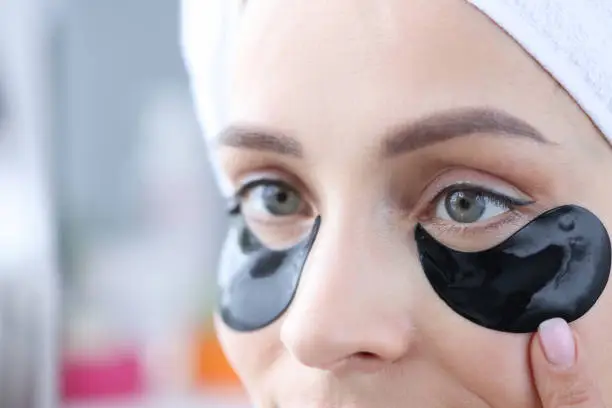
- If you use moisturizer, allow it to absorb for at least 10 minutes before applying makeup. You want the foundation to remain in place, and swelling can lead to skin dryness.
- Put a layer of concealer that is one shade lighter than your natural skin tone over the whole bruise. If your bruise appears blue, seek out a concealer that has a yellow base color to counteract the bruise’s hue. Similarly, if your bruise has a green tint, opt for a concealer that has a red undertone.
- For yellow bruises, opt for a concealer that has a lavender base color.
- Put a layer of foundation on your face. Pat – don’t rub it in – to mix.
- Apply a light layer of translucent powder to your face.
Other than the aforementioned methods—ice packs followed by heat, use of non-prescription analgesics, and elevation of the affected area if feasible—there is no special treatment for bruises provided by doctors. If your physician has fears of domestic abuse, you might be referred to a social worker.
If you have a medical condition that causes you to bruise easily, your doctor will address that condition. As an example, if you:
- If you are on a medication that leads to bruising, your doctor might change your prescription to another one. If you have a vitamin deficiency, your doctor might recommend vitamin supplements.
- If you are suffering from an infection, cancer, or an autoimmune disease, your doctor will either treat you or direct you to a specialist for treatment. If you have liver disease, your doctor may administer vitamin K or perform a plasma transfusion.
Ways to make bruises heal overnight
Although a lack of substantial support from strict medical research, a widespread belief exists that particular alternative home remedies can significantly hasten the healing of facial bruises. Before approval of any treatment plan, always consult your physician.
Arnica
Proponents of natural healing believe that the herb arnica can quickly reduce inflammation, swelling, and bruising discoloration. While it is possible to take mixed arnica orally, they advise applying topical arnica gel to your bruise twice daily.
Vitamin K cream
Applying vitamin K cream to your bruise twice daily could facilitate its healing process.
Vitamin C
Proponents of natural medicine back the notion of consuming vitamin C-rich foods — or using a vitamin C supplement — to facilitate bruise healing. The body can reduce inflammation with the help of vitamin C. It is also recommended to apply a gel or cream with vitamin C directly onto the bruise.
Bromelain
Bromelain, a combination of enzymes present in pineapple and papaya, is suggested by proponents of natural healing for its potential to lessen inflammation and prevent the formation of blood clots. They support the notion that a bromelain supplement of 200 to 400 milligrams can accelerate bruise disappearance. It is also advised to crush pineapple and/or papaya into a pulp, then apply it directly to your bruise.
Cayenne pepper
Many people believe that the compound present in hot peppers can help reduce bruising and pain. It is suggested to create a mixture of one part cayenne pepper and five parts melted petroleum jelly (Vaseline) and apply it to your bruise.
Comfrey
Advocates of natural healing advise using a cream with comfrey or a compress made from boiled dry comfrey leaves to facilitate bruise healing.
Vinegar
Some individuals think that applying a combination of vinegar and warm water to the bruise may improve blood circulation to the skin’s surface, thus enhancing the healing process of the bruise.
Bilberry
In the view of some advocates of home remedies, taking blueberry juice can help stabilize collagen and strengthen capillaries, thus enhancing faster bruise healing.
Prevention
Everyone goes through bruising. By taking these measures, you can reduce your chances of injury and bruising:
- Use protective equipment (such as shin guards) when engaging in contact sports like football.
- Keep furniture clear of doorways and the usual walking routes in your house.
- Keep phone and electrical cords out of open areas where you might trip and fall.
- Ensure that your floors remain dry and that your rugs are slip-resistant.
- Ensure that floors are free of garbage.
- If your physician has recommended anticoagulant medications, ensure you undergo regular monitoring and adjust the drugs as needed.
- Ensuring that floors and rooms are free of objects that could cause a trip.
- Moving accessories from doorways and walkways to prevent collisions with hard surfaces.
- Enchanting your path with a light or flashlight while crossing weakly lit regions.
- Having sufficient vitamins in your diet.
- Using protective equipment such as helmets and pads while engaging in contact sports, cycling, or motorcycling.
It’s difficult to avoid bruises entirely. However, if you are engaging in sports activities, cycling, inline skating, or any other activity where collisions may occur, it is wise to wear protective equipment such as pads, shin guards, and helmets. If you take just a few extra seconds to put on that gear, it might save you from a couple of weeks of aches and pains.
Prognosis
While bruises can look bad, most of them go away on their own without any treatment. At times, bruises can indicate a more significant problem. Therefore, consult a healthcare professional if you have large or unexplained bruises. Some kinds of bruises, like hematomas, might need medical attention.
What Is the Duration of Bruises?
It typically takes around two weeks for bruises to fade. During that period, the bruise shifts in color as the body metabolizes and recovers the blood. The hue of the bruise can indicate its age:
- When a bruise first occurs, it has a reddish tint as blood seeps under the skin.
- Within a day or two, the hemoglobin (an iron-containing substance responsible for oxygen transport) in the blood alters, causing the bruise to take on a bluish-purple or even black color.
- In the aftermath of 5–10 days, the bruise takes on a green or yellow shade.
- The bruise finally disappears.
What are other kinds of likely blood loss?
Various forms of bleeding can lead to skin discoloration, including:
- Hematoma: Trauma, like a car accident or a significant fall, can lead to the formation of a hematoma. A hematoma refers to a larger accumulation of blood outside the blood vessels, which is usually raised and painful when touched.
- Petechiae: These are tiny (under 2 millimeters) pinpoint reddish dots on your skin that do not turn white when gentle pressure is applied.
- Purpura: This refers to minor bleeding beneath the skin. Purpura is of intermediate size between petechiae and ecchymosis.
Conclusion
It is normal to acquire occasional bruises from small injuries, like inadvertently hitting a body part against a doorframe. Nevertheless, bruises can also arise from more serious medical issues, such as varicose veins and leukemia.
It is crucial to consult a healthcare professional if you experience repeated bruising without an apparent cause or persistent burning sensations that last for months. It could stem from a health issue that requires immediate treatment.
FAQs
Can bruises result in a lasting mark?
No, not particularly. Occasionally, you might notice a persistent bruise. This could be due to a repeated injury in the same spot, a blood clotting disorder that causes consecutive bruising, or another skin condition. In this situation, it is advisable to consult your doctor to determine what the issue is.
What color characterizes a serious bruise?
It’s difficult to assess how serious a bruise is based on its color. The appearance of a bruise varies based on several factors, such as your natural skin tone, the severity of the injury that caused it, and its duration. Until the bruise has fully healed, you will likely notice some discolored skin. However, a serious bruise is more often characterized by being large, painful, swollen, or lumpy.
What is the duration for a bruise to go away?
Depending on the severity of your injury, bruises usually heal independently within approximately two weeks. A hematoma, for example, is more severe than a typical bruise and can require over a month to heal. Consult your doctor if you have a bruise that persists for more than two weeks.
What is the healing duration of a bruise?
It typically takes around two weeks for bruises to fade. During that period, the bruise shifts in color as the body metabolizes and reabsorbs the blood. The bruise’s color indicates its age: Initially, when a bruise occurs, it appears reddish due to blood surfacing beneath the skin.
What can I do to speed up the fading process of bruises?
You can facilitate quicker healing of your bruises by: Resting and elevating the injured area to avert swelling and ease pain. Use ice packs during the first 24 to 48 hours following injury. Ice should be applied using a towel-wrapped ice pack for intervals of no longer than 15 minutes.
What do bruises indicate?
A bruise, or contusion, occurs when an area of the body is hurt and blood from injured capillaries (small blood vessels) seeps out. When there’s no place for the blood to escape, it becomes trapped beneath the skin, resulting in a tender red or purplish mark upon contact — a bruise.
What are love bites?
Essentially, it is a bruise resulting from bleeding beneath the skin due to minor damage to superficial blood vessels (blood capillaries). Since these bruises occur during sexual intimacy, they are referred to as love bites or kiss bites.
Can a lack of iron lead to bruising?
Contusion. In cases of iron deficiency anaemia, the bone marrow lacks an adequate iron supply. In addition to the inability to produce sufficient red blood cells (anemia), there may also be a decrease in the production of platelets. Since platelets are the initial component in the blood coagulation process, a decrease in their number results in more frequent bruising.
Reference
- Bruises (Ecchymosis). (2025, March 19). Cleveland Clinic. https://my.clevelandclinic.org/health/diseases/15235-bruises
- Bruises (for teens). (n.d.). https://kidshealth.org/en/teens/bruises.html
- King, L. M., PhD. (2024, May 23). Bruises. WebMD. https://www.webmd.com/skin-problems-and-treatments/bruises-article
- Why do I bruise easily? (n.d.). WebMD. https://www.webmd.com/skin-problems-and-treatments/ss/cm/slideshow-why-bruise-easily
- Easy bruising: Why does it happen? (n.d.). Mayo Clinic. https://www.mayoclinic.org/healthy-lifestyle/healthy-aging/in-depth/easy-bruising/art-20045762
- Fletcher, J. (2024, January 18). What do the colors of a bruise mean? https://www.medicalnewstoday.com/articles/322742
- Anatomy of a bruise. (n.d.). WebMD. https://www.webmd.com/first-aid/ss/slideshow-bruise-guide
- Bruise: MedlinePlus Medical Encyclopedia. (n.d.). https://medlineplus.gov/ency/article/007213.htm

